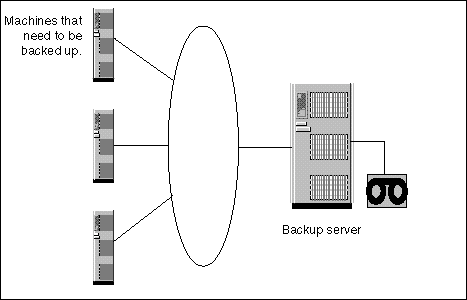 |

 IBM-AUSTRIA - PC-HW-Support 30 Aug 1999
IBM-AUSTRIA - PC-HW-Support 30 Aug 1999 |
Single Server Model
Single Server Model
As opposed to the
direct connection model,
this type of setup is based on a backup server,
connected through a network to the machines that will need to take a
backup. These machines are often referred to as clients or agents.
The tape device (or other storage media) will be connected to this
backup server (see Figure 5). The advantages of this design are that
centralized storage administration is possible and the number of storage
devices is reduced (and probably the cost).
However, the problem here
could be the network bandwidth. Since all data that is backed up needs
to go over the network, the throughput is smaller than what we have
using a direct tape connection. Every client that is added will need
some of this bandwidth (see
Network Bandwidth Considerations).
This bandwidth issue becomes even more important when dealing
with a distributed site. Let's imagine that one of the machines that
needs to be backed up is located in a different location than the backup
server, with only a very slow link between these two sites. Throughput
could diminish in such a way that it would take longer than 24 hours to
back up the remote system. In this case, a
two-tier solution
would be better.
Another disadvantage is that the machine used as backup server should
be a dedicated machine. The reason for this is that backup and restore
operations would have an impact on this server's performance. If you
included it in the regular server pool, it could slow down all
operations on the network servers.

Figure 5. Single Server Model
This design is well suited for sites with a
limited number of machines. There are multiple reasons for this:
- For example, network bandwidth is not unlimited.
- Another reason for the
limit on clients that a single server will support is that each session
will use resources (processor, memory) on the backup server.
Back to 
More INFORMATION / HELP is available at the IBM-HelpCenter
Please see the LEGAL - Trademark notice.
Feel free - send a  for any BUG on this page found - Thank you.
for any BUG on this page found - Thank you.

 for any BUG on this page found - Thank you.
for any BUG on this page found - Thank you.